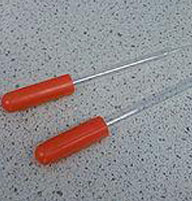l'aide d'une pipette pasteur, également appelé pap tubes, tuyaux polymère liquide transparent, souvent en polyéthylène (pe), etc., divisé en rayon gamma de stérilisation et de désinfection deux pap pailles. ils ont différents volume et longueur, sa caractéristique est une capsule sur le tube corps creux, peut faciliter le solvant mixte reagents et tube corps cellulaire, etc. translucide, bright white, mur liquide idéale, facile à contrôler; peut être utilisée pour l'azote liquide; jouer bien mou, souple, facilement retracer ou conteneur spécial; petite aspiration peut assurer la répétabilité du liquide baisse en volume, peut être qu'illors de la fermeture, facile à transporter. demande principale cellule expérience, les essais cliniques, le clonage, etc. le dessin d'une petite quantité de liquide, le transfert ou l'opération, etc. largement utilisée en génétique clinique, la prévention des épidémies, médecine, génétique, biochimique, pétrochimie, militaires et autres domaines,produits jetables de consommables appartenant au labo.
pipettes pasteur, également connu sous le nom de gouttes ou compte - gouttes oculaire, est utilisé pour le transfert de petites quantités de liquides [1]. ils sont habituellement des tubes de verre graduellement à un point précis, et munis d'une poire en caoutchouc au sommet.la combinaison de la pipette pasteur et poire en caoutchouc a également été mentionné comme une solution de pipette.pipettes pasteur venu en diverses longueurs et sont vendues dans des boîtes de centaines. [citation nécessaires] ils sont nommés après le scientifique français louis pasteur, qui était connu pour avoir utilisé une variante de l'étendue au cours de ses recherches.généralement, ils sont considérés comme suffisamment bon marché pour être jetables, cependant, aussi longtemps que le verre n'est pas cassé, la pipette pasteur peut être lavé et réutilisé indéfiniment.
le nom de compte - gouttes peuvent également consulter les premiers modèles de stylos, qui doivent être remplis avec une sorte de pipette pasteur.
caractéristiques des produits+
|
Products information |
|||
|
Part No |
Volume(ml) |
Length |
Material |
|
PP01145 |
3 |
145 |
LDPE |
|
PP02150 |
2 |
150 |
LDPE |
|
PP03160 |
1 |
160 |
LDPE |
|
PP2100 |
0.2 |
100 |
LDPE |
|
PP5120 |
0.5 |
120 |
LDPE |


Informations techniques+
Diagramme de flux de processus+
FAQ+
Enquête
Si vous avez n'importe quelle question ou commentaire, svp contactez-nous sans hésitation. Nous vous répondrons dès que possible. ( * informations requises)
avez - vous une question concernant nos produits?
contactez - nous